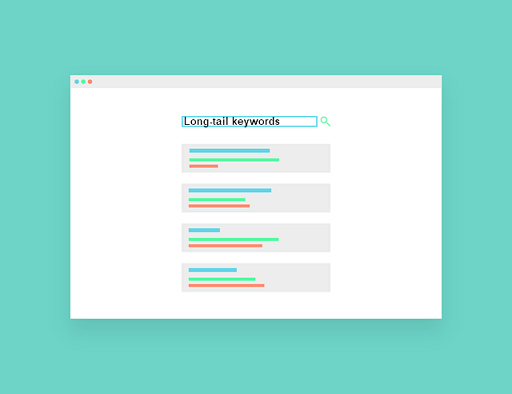70% of all searches are done with long-tail keywords. About 30% of the keywords that account for 10,000+ monthly searches on Google are made of 3 or more words.
These are what we usually refer to as long-tail keywords. However, commonsense understanding apart, this is not the precise definition of long-tail keywords. That’s not where the term itself comes from!
The search demand curve is in the shape of a tail of a Chinese dragon. It tapers from left to right. The search volume decreases as we move rightwards. The number of words per query and the number of unique search queries increases too as we move right. The right-half of the curve is called the long tail-end of the curve.
Keywords containing 3 or more words are covered under this portion of the curve. Hence the name!
This is how a leading SEO company in Delhi defines long-tail keywords:
“Long-tail keywords are those less popular keyword phrases that are used for more specific searches. They capture user intent and thus offer greater conversion rates. They have low competition, search volume and CPC.”
The Google algorithm is increasingly taking the tricks of the trade out of the SEO. They are being replaced by the quest for genuine content that straightaway serves the user’s purpose. Moreover, voice-search has changed the way people search. Long-tail keywords are now central in strategies of SEO agencies in Delhi to ensure higher rankings and more conversions.
A best SEO company in Delhi can rank your pages for 30+ keywords by optimizing for just 6 long-tail keywords.
Let’s see how!
The long-tail keyword strategy comprises of 3 tasks.
Finding and determining the keywords, integrating keywords with the content and implementing the optimization.
#1. Finding and Finalizing the Long-tail Keywords
- Topical Long-tail Keyword
The rule of the thumb is to move from long-tail towards the head keywords. Your main long-tail keywords should exactly match the service, product or information you are offering, with the users’ intent. It is also known as the topical long-tail keyword. It could be the longest long-tail keyword of your strategy.
- Supporting Long-tail Keyword
Thereafter, we move to finding the keywords to support the long-tail by using variations. This is done by:
- Trying to think from the customer or user end to look for phrases.
- Finding hints for search phrases from online communities.
By using the Google auto-complete suggestions or professional keyword tools we hunt for less specific searches. Obviously, the competition for the keyword would rise as we move towards more generic keywords.
A balance between the exactness of intent (without wavering from the search topic) and competition provides possible supporting keywords.
These can be same word-length or shorter than the topical keyword.
- Moving towards the Head Term
The head term is the search term that indicates the broader topic of which the long-tail keywords are subtopics.
The head term would have very high search volume and competition. However, by ensuring that the head term appears in the supporting long-term keywords, the ranking potential increases manifolds.
The 2017 Hummingbird update already raised the emphasis on contextual search results. Recently applied Google RankBrain algorithm clubs the search results taking user intent into account. Head-term inclusion in the supporting long-tail keywords means that your page gets ranked for many more closely related keywords. Also, your page gets ranked for shorter keywords automatically.
Thus optimizing for one 5 word keyword means that you would be ranked for at least 5 different keywords.
That’s where a best SEO company in Delhi NCR would begin! There is plenty more to ranking for 30+ keywords by optimizing for half-dozen long-tailed keywords.
#2. Integrating the Long-tail Keywords with Content
The full advantage of smart keyword selection is possible when keywords are naturally placed in the content. Fit the main keyword in the title, intro and conclusion. Other keywords may be used in subheadings. Using long-tail keywords in the title tag, URLs and meta-descriptions is must. Using them in image-text would be beneficial.
A bonus with using long-tail keywords is that they can be used through the split and combine method.
Use two long-tail keywords in sequence such that the end of first and the beginning of second makes a meaningful search term. They should be placed naturally. Even though you would not need to optimize for this new search term, your page would still rank for it.
This way you rank for a far greater number of keywords than you have optimized for. Few helpful rules are:
- It would better if one of the two combined keywords is the main long-tail keywords.
- Each post should ideally be around one long-tailed keyword (topical). Thus, your keywords decide what content goes into the blog/website.
- See that except for the main long-tail keyword, others are not very particular. It will be difficult to design content that way. Moreover, Google gives emphasis to broader topic and context.
#3. Implementing the (Re)Optimization
Here are a few useful tips for optimizing and re-optimizing the pages:
- Use the long-tail keywords in the anchor text for internal linking.
- Add content to an existing page that is around the long-tail keywords after reviewing the results. This can also be done by adding H2 sections with keywords.
- After reviewing the performance of the initial set of long-tail keywords, find the better performing ones. Find the adjacent keywords for which the pages get ranked. Substitute these for the less performing supporting keywords, add H2 level content, and re-optimize.
Special emphasis should be placed on natural keyword integration with content while each re-optimization.
Website Designing Company in Delhi that Offers Specialized Long-tail Keyword Strategy
Long-tail keywords are driving the SEO strategy of small businesses. They are also crucial for those who are seeking to build a dominating web presence. The interlinking of website content and marketing content is a must for attracting organic traffic. This is best possible with the services of a competent website designing company with a team of smart content strategists.
Here’s an example of some of the long-tail keywords for which we optimized our client’s SEO program.
| Long-tail Keyword | Google Page Ranking | Client | Small Keywords Included |
|---|---|---|---|
| motorola walkie talkie dealers in Delhi | 1 | Max Telecom | motorola walkie talkie, motorola walkie talkie dealers, walkie talkie dealers in Delhi |
| property management company for NRI landlords in India | 1 | LuXia LLP | property management company, property management company for NRI, property management company for NRI landlords |
| cannabis consultants for licensed producers in Canada | 1 | Genesis Cannabis Solutions | cannabis consultants, licensed producers, cannabis consultants for licensed producers, licensed producers in Canada |
| barber shops for men rancho cucamonga CA | 1 | Draft Cuts | barber shops, barber shops for men |
Get in touch with our SEO company to rank on the top page for target and high performing long-tail keywords.

